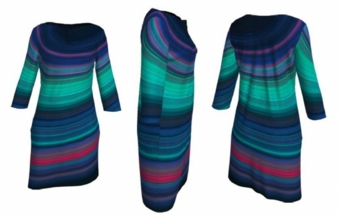28/01/2015 — auf Deutsch lesen
A perfect fit from the web
Digital fashion is a challenge and the European answer to textile mass production from the Far East. It is supposed to push classic clothing “Made in Germany” and to reach millions of customers, who were – due to special requirements – not satisfied up to now.
Fashion-Able und Corenet are two projects funded by the EU which deal with this subject. German research institutes and some well-known local manufacturers participate in these projects. Their results confirm the predicted noticeable change in the areas of confection and consumption. Digital measurement cabins, personalized clothing by the configurator, user-friendly integration of functional features and overnight-production close to the buyer could change the whole value chain significantly. Thomas Strobel, expert for futuristic issues, from Munich considers “alternative production technologies such as adhesive bonding or laser welding and 3D-production processes as requirements for individual made-to-measure production”.
Postural damage, obesity or an extraordinary body height, wheelchair users or diabetics with foot issues – they all have something in common: They have special requirements regarding individually optimized clothing characteristics. The same applies to high-performance athletes. “The mentioned groups normally require expensive custom-built clothing or have to cope with standard fittings, made-to-measure on Grandma’s sewing machine,” explains Dr.-Ing. Thomas V. Fischer from the Centre of Management Research of the German Institute for Textile and Fibre Research (DITF-MR).
The full digital process chain – from the first virtual draft to the printing on the fabrics – is a real alternative approach. Latest technologies for the simulation of material, cut and people, the textile design, pattern-making and printing are integrated in the process; the simulation is directly combined with secondary processes such as sample-production and manufacturing. The exact body dimensions of the wearer are recognized by contact-free 3D-Bodyscanning; textile researchers of the Hohenstein Institutes in Bönnigheim near Stuttgart are leading in this area.
With "Simulate, Print and Go!", ready-made for the market by DITF-MR together with the company Human Solutions and Software designer ErgoSoft, a full process for virtual product design and digital production is available for the first time ever. An example for using it in real life is the Fashion-Able-Project: By means of CAD-tools medical textiles, such as orthosis for the relief of postural damages, backache or joint injuries were customized absolutely accurate. Even the prototyping of a virtual test for the perfect fit regarding tension and extension of the supporting device and the display of its distance to the customer’s body was part of the digital chain. Up to now, manufacturers used expensively constructed and complicated proto-types for that.
Fashion-Able wants to “provide” innovative European SME with new technologies for customer-oriented Co-Design as well as with the development and sustainable production of individualized products, such as flexible leather, 3D-Spacer fabrics, new textile finishings as well as flexible production processes and machines. In addition to compression orthosis, also shoes for diabetics and clothing for wheel chair users were digitally developed. They are tested now.
In the project Corenet (Customer-Oriented and Eco-friendly Networks for healthy fashionable goods) with 13 partners from 6 European countries the textile design was based on actual body measurements. Comfortable, properly fitting apparel with optimized design for obese people – a target group, quite neglected by the commerce – were also made via web-based “Co-Design”.
Digital fashion as a consistent process based on sustainability saves time and increases the design quality; with smaller production series manufacturers can react more flexibly to the market. Furthermore, customized (medical) textiles are a large niche market and improve quality of life considerably for the people affected. The number of people, who have a need of such customized products, is estimated at about 100 million, including 30 million diabetics, who need special shoes.
“By combining technologies such as lCT (Infrormation and Communication technology), biomechanics and production technologies an important link between medicine and textile industry has developed“, emphasised Dr. Thomas V. Fischer. “This way products, both – innovative and according to special target groups – far from any standardized goods can be developed and tested directly in the new markets.” Concrete offers to the industry are supposed to ensure experience with the new technology, with an implementation time of approximately 3 to 5 years. “In 10 to 15 years, the Central European clothing will be much more diverse”; the research engineer from Denkendorf is convinced. “Up to 20 percent will wear sustainable material and individually designed textiles.”





